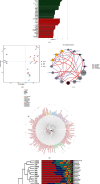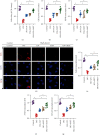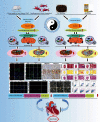Traditional Chinese Medicine Ginseng Dingzhi Decoction Ameliorates Myocardial Fibrosis and High Glucose-Induced Cardiomyocyte Injury by Regulating Intestinal Flora and Mitochondrial Dysfunction
- PMID: 35401934
- PMCID: PMC8989614
- DOI: 10.1155/2022/9205908
Traditional Chinese Medicine Ginseng Dingzhi Decoction Ameliorates Myocardial Fibrosis and High Glucose-Induced Cardiomyocyte Injury by Regulating Intestinal Flora and Mitochondrial Dysfunction
Abstract
Myocardial fibrosis refers to the pathological changes of heart structure and morphology caused by various reasons of myocardial damage. It has become an important challenge in the later clinical treatment of acute myocardial infarction/ischemic cardiomyopathy or diabetes complicated with heart failure. Ginseng Dingzhi Decoction (GN), a Chinese herbal medicine, can reduce heart failure and protect cardiomyocytes. We infer that this may be related to the interaction with intestinal microbiota and mitochondrial homeostasis. The regulatory mechanism of GN on gut microbiota and mitochondria has not yet been elucidated. The intestinal microbiota was analyzed by the 16S rRNA gene; the fecal samples were sequenced and statistically analyzed to determine the changes of microbiota in the phenotype of heart failure rats. In addition, GN can regulate the microbial population that increases the proportion of short-chain fatty acids and anti-inflammatory bacteria and reduces the proportion of conditional pathogens to diabetic phenotype. The results suggest that GN may improve myocardial injury by regulating intestinal flora. Our data also show that stress-type heart failure caused by TAC (transverse aortic constriction) is accompanied by severe cardiac hypertrophy, reduced cardiac function, redox imbalance, and mitochondrial dysfunction. However, the use of GN intervention can significantly reduce heart failure and myocardial hypertrophy, improve heart function and improve myocardial damage, and maintain the mitochondrial homeostasis and redox of myocardial cells under high glucose stimulation. Interestingly, through in vitro experiments after TMBIM6 siRNA treatment, the improvement effect of GN on cell damage and the regulation of mitochondrial homeostasis were eliminated. TMBIM6 can indirectly regulate mitophagy and mitochondrial homeostasis to attenuate myocardial damage and confirms the regulatory effect of GN on mitophagy and mitochondrial homeostasis. We further intervened cardiomyocytes in high glucose through metformin (MET) and GN combination therapy. Research data show that MET and GN combination therapy can improve the level of mitophagy and protect cardiomyocytes. Our findings provide novel mechanistic insights for the treatment of diabetes combined with myocardial injury (myocardial fibrosis) and provide a pharmacological basis for the study of the combination of Chinese medicine and conventional diabetes treatment drugs.
Copyright © 2022 Junyan Wang et al.
Conflict of interest statement
The authors declare that there is no conflict of interest regarding the publication of this paper.
Figures












Similar articles
-
Zishenhuoxue decoction-induced myocardial protection against ischemic injury through TMBIM6-VDAC1-mediated regulation of calcium homeostasis and mitochondrial quality surveillance.Phytomedicine. 2024 Sep;132:155331. doi: 10.1016/j.phymed.2023.155331. Epub 2023 Dec 30. Phytomedicine. 2024. PMID: 38870748
-
SIRT5-Related Desuccinylation Modification Contributes to Quercetin-Induced Protection against Heart Failure and High-Glucose-Prompted Cardiomyocytes Injured through Regulation of Mitochondrial Quality Surveillance.Oxid Med Cell Longev. 2021 Sep 23;2021:5876841. doi: 10.1155/2021/5876841. eCollection 2021. Oxid Med Cell Longev. 2021. PMID: 34603599 Free PMC article.
-
Alleviation Effects of GQD, a Traditional Chinese Medicine Formula, on Diabetes Rats Linked to Modulation of the Gut Microbiome.Front Cell Infect Microbiol. 2021 Oct 8;11:740236. doi: 10.3389/fcimb.2021.740236. eCollection 2021. Front Cell Infect Microbiol. 2021. PMID: 34692563 Free PMC article.
-
Mitochondrial disorder and treatment of ischemic cardiomyopathy: Potential and advantages of Chinese herbal medicine.Biomed Pharmacother. 2023 Mar;159:114171. doi: 10.1016/j.biopha.2022.114171. Epub 2023 Jan 13. Biomed Pharmacother. 2023. PMID: 36641924 Review.
-
Protective Effect of Natural Medicinal Plants on Cardiomyocyte Injury in Heart Failure: Targeting the Dysregulation of Mitochondrial Homeostasis and Mitophagy.Oxid Med Cell Longev. 2022 Sep 12;2022:3617086. doi: 10.1155/2022/3617086. eCollection 2022. Oxid Med Cell Longev. 2022. PMID: 36132224 Free PMC article. Review.
Cited by
-
The Role of Mitochondrial Quality Control in Anthracycline-Induced Cardiotoxicity: From Bench to Bedside.Oxid Med Cell Longev. 2022 Sep 21;2022:3659278. doi: 10.1155/2022/3659278. eCollection 2022. Oxid Med Cell Longev. 2022. PMID: 36187332 Free PMC article. Review.
-
Diabetic Cardiomyopathy Uncovered: Transcriptomics, NLRP3, and Carvedilol Mechanisms.J Diabetes Res. 2024 Nov 23;2024:9378405. doi: 10.1155/2024/9378405. eCollection 2024. J Diabetes Res. 2024. PMID: 39619569 Free PMC article.
-
Modulation of the Cardiovascular Risk in Type 1 Diabetic Rats by Endurance Training in Combination with the Prebiotic Xylooligosaccharide.Int J Mol Sci. 2024 Sep 18;25(18):10027. doi: 10.3390/ijms251810027. Int J Mol Sci. 2024. PMID: 39337515 Free PMC article.
-
The application and mechanism of Chinese medicine in the upstream treatment of atrial fibrillation.Front Cardiovasc Med. 2023 Aug 7;10:1229021. doi: 10.3389/fcvm.2023.1229021. eCollection 2023. Front Cardiovasc Med. 2023. PMID: 37608811 Free PMC article. Review.
-
Important regulatory role of mitophagy in diabetic microvascular complications.J Transl Med. 2025 Mar 4;23(1):269. doi: 10.1186/s12967-025-06307-7. J Transl Med. 2025. PMID: 40038741 Free PMC article. Review.
References
MeSH terms
Substances
LinkOut - more resources
Full Text Sources
Medical
Miscellaneous

